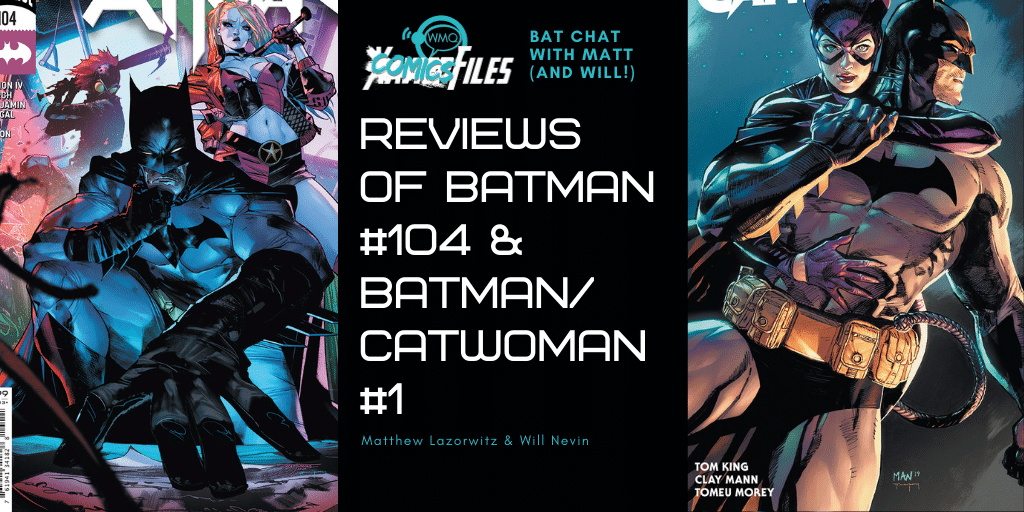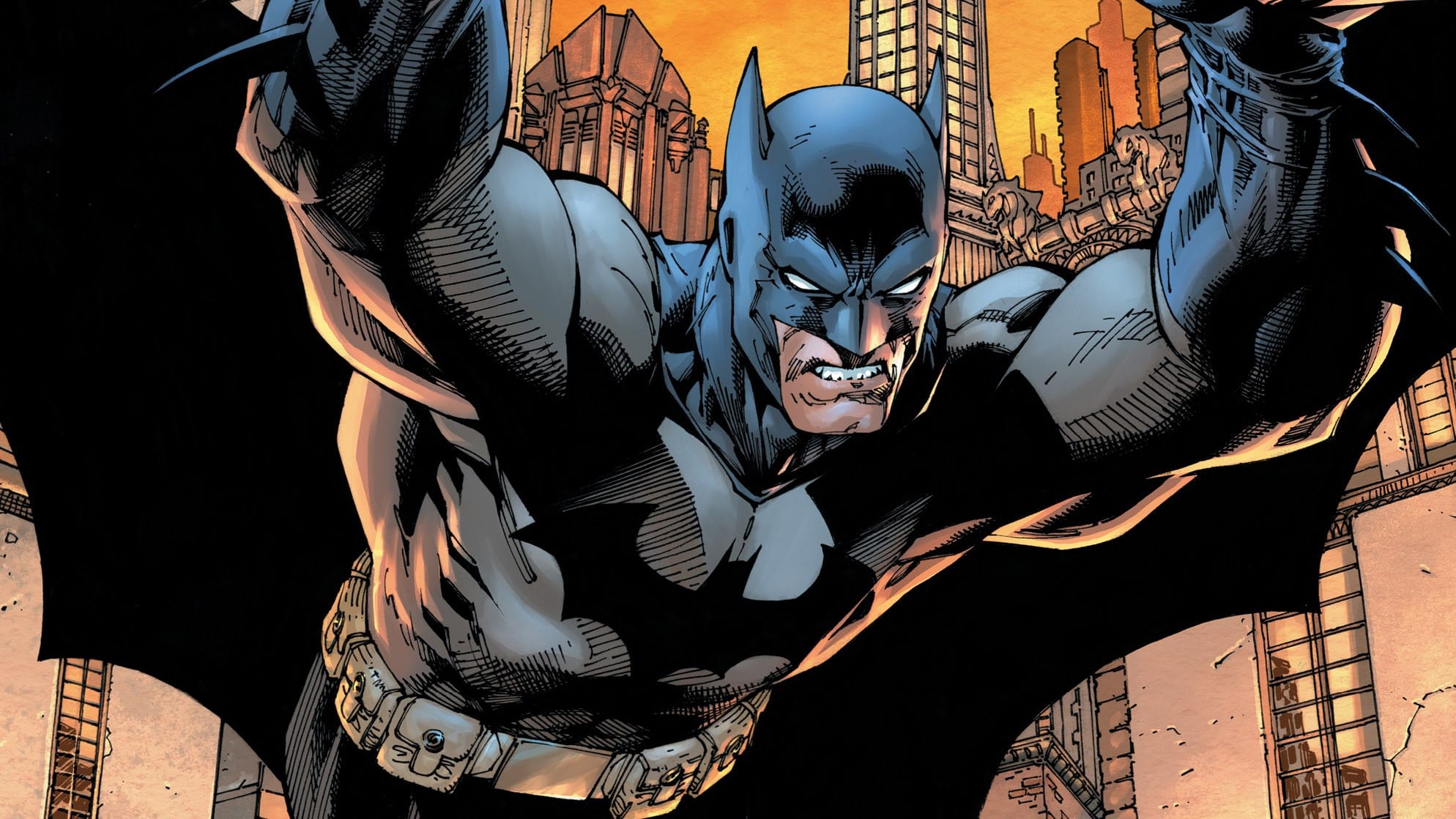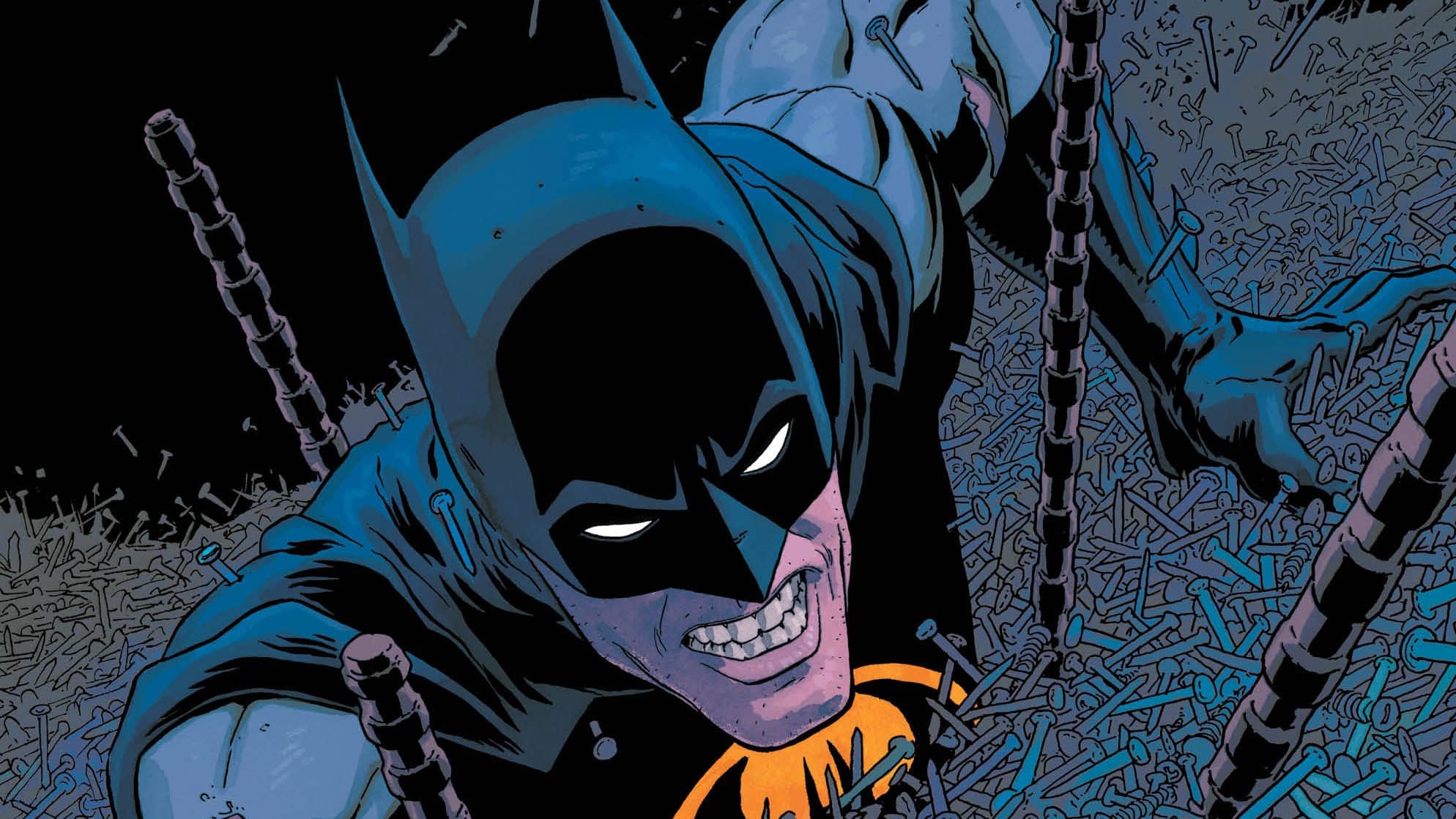Will Nevin: This is a heckuva week, but for mostly the wrong reasons — because while Bat/Cat #1 (I can’t believe Tom King resisted his urge to go there again) was overwhelmingly fine, Batman #104 is — and I say this with as little hyperbole as possible — an embarrassing look at when a comic book’s artistic process breaks all the way down.
Matt Lazorwitz: Yes, we are once again in agreement. Let’s just get to it, because if I start venting here I don’t think I’ll be able to stop.
Batman #104
Captured by Ghost-Maker, Batman, Harley Quinn and Clownhunter are in deep trouble while the rest of the Bat family searches for Batman and Nightwing reveals Ghost-Maker’s origin in Batman #104 from James Tynion IV, Ryan Benjamin, Danny Miki, Bengal, Guillem March, David Baron and Clayton Cowles.

ML: In our last review of Batman, I said the only thing that could make Ghost-Maker finally work was a miraculous origin that made him a deeper character and made me care about him. Well, we got that origin this issue … and it did not work that way. It actually made him a more shallow character; this guy obsessed with being the world’s best crime fighter because he can. So he’s weaponized hipster shallowness. It’s not even that new a hook; Lady Shiva’s whole thing is she wants to be the world’s greatest fighter because she wants to be the world’s greatest fighter, only she’s got a cool design and an interesting backstory that gives her motivation for wanting to be the best.
WN: It’s rare when a character’s origin story can do damage not only to them but to someone else as well, and yet that’s what we have here: Ghost-Maker is still a thimble-deep idea, but his early friendship with Bruce (and Ghost-Maker’s subsequent decision to end the relationship) now makes Bruce’s opposition to what he does not a thing of principle but one of petulance. And all of this is revealed in a ham-fisted flashback to a conversation between Batman and Robin … because, you know, Batman is known for being so talky and open. Bad characterization. Bad exposition. Just plain bad!
ML: Ghost-Maker is just a greatest hits compilation being played by a cover band that is tone deaf. Mysterious character from Bruce Wayne’s past? We already have Hush and now an in-continuity Phantasm for that. Guy who tries to prove he’s better than Batman? That’s Bane’s whole deal. A friend turned enemy? Two-Face has been doing that shtick since his post-Crisis origin. There is now no saving grace left for this character.
And by the way, do you think Ghost-Maker is a big fan of the “Saw” franchise? Because that’s all his trap for Batman is. Lock him in a creepy hospital room and force him to do something. I don’t believe there are no new ideas under the sun, but superhero comics have been going a long time and there’s a lot of derivative ideas, but they can have cool things done with them. This is just not one of them.
WN: “A greatest hits compilation being played by a cover band that is tone deaf.” That’s a helluva zinger. Wish I had thought of it. It’s funny that the abysmal quality of the art — a problem we haven’t even gotten to — covers up so many of the narrative problems in this issue, like the fact that this is a goofy “Saw” trap *and* this issue is super decompressed, with Batman and friends being knocked out at the end of #103, Batman waking up at the beginning of #104 and everyone else waking up at the end. Literally nothing happens in real time in our main scene. But, again, when the art is such shit, it’s hard to complain about anything else — sorta like nitpicking the cinematography of “Rise of Skywalker” (except, of course, it was the writing there that was doody).
ML: I think we’ve called this out before, but something made especially clear in this issue is a real problem with books that double ship. Not every artist is Mark Bagley, who was able to do one and a half or so issues of “Ultimate Spider-Man” for what, about five years? By double shipping this book, we’re getting wildly inconsistent art to begin with, which in a “write for the trade” world is a bad thing because even two artists with different styles drawing one story in a trade can be off-putting, unless it’s a one artist on plot A/one on plot B or one in the present/one in the past thing where it’s coordinated. This is not that. This is a rush job. The art styles are inconsistent from one page to the other, and not one of them is appealing.
WN: The one Rebirth-era series that has pulled off double shipping was Greg Rucka’s “Wonder Woman,” and it did so precisely with what you suggested: alternating storylines done by different artists. I’m not sure if DC has even considered a similar approach with any other book, and while a lot of them have suffered, no single issue has been this bad. “Embarrassing” is probably the best way to put it: minimal attention to backgrounds, Oracle staring at solid blue computer monitors that are supposed to be teeming with information and Nightwing being a lumpy caricature are just the worst moments I can recall from memory. Double shipping or not, there’s no excuse to put out a book this bad.
ML: The one that got me was the page with young Bruce fighting young Ghost-Maker (and I wish we had his real name by now, because I’m tired of writing that dumbass codename over and over). Half the page is a big panel of a flying kick, and it’s supposed to look like Ghost-Maker is connecting, but the way his leg is bent, it looks like his knee is dislocated and flapping. I looked at that panel and had to ask my wife to look at it and confirm for me that is not how legs work, because I thought I was going crazy, since no way could a panel with anatomy that bad make it past editorial.
WN: You know, we’re not bound by anything other than whatever we can get past editor Boss Man Dan. We could start calling Ghost-Maker “Snideface McShitburger” or anything else we wanted. [Grote’s note: As long as there’s an asterisk somewhere leading to a box that says “*Ghost-Maker. — Delineatin’ Dan.”]
But yes, to your actual point, it’s all bad. And given there are *four* artists credited, it can’t even be uniformly bad, so we’ve got hiccups and quirks and all sorts of weirdness jumping around. This isn’t even art that doesn’t look good in trade as you mentioned — this is art that doesn’t flow from one page to another.
Batman/Catwoman #1
After 85 issues on Batman, Tom King returns to tell a story of Batman and Catwoman’s love in three time periods, while nodding to some of the best and worst of Batman: The Animated Series in Batman/Catwoman #1 from Tom King, Clay Mann, Tomeu Morey and Clayton Cowles.

WN: Reading #104 and then chasing that with Batman/Catwoman #1 was the way to do it because I was able to see the opening splash of Wayne Manor (I think that’s the manor, anyway) with all of its loving details and shadows and think, “Ahh, yes, this is what a professional comic book should look like.” Otherwise, like I said up there in the open, I found this to be overwhelmingly OK — not a disaster mess like the Murphyverse but not the first chapter of an opus either. (Although, to be fair, it might get there.) This felt very much like King’s standard Batman with a little more care and attention and time — which is, ya know, exactly how we got this series after he was pulled from the book before the end of his 100-issue run.
The timelines/narrative structure that you mentioned in the summary there is not necessarily a bad way to go about writing the issue, but a lot of the shifting around felt jarring and not in a breathless, high-stakes sort of way but in a “this is confusing and disorienting” way. How about you lay out the timelines for the good people?
ML: That is indeed Wayne Manor, and I liked that quite a bit, especially as I think, judging by the 12 numbered windows/doors, each issue will fill in one as the series continues, which is a cool little effect and something similar to the evolving back pages of The Long Halloween, which is a nice visual cue to another Batman maxiseries.
Right there with you on the timelines. I wish there was a better visual indicator for each of the timelines. I thought we were getting that, as there were distinct color tones to the different timelines at the beginning of the book, but they weren’t used consistently. Bruce’s meeting with Andrea in the present is in an orange, but the next time that hue is used is when Catwoman meets Joker in the past. Coloring is often one of those art forms that is subtle, and only becomes very noticeable if it’s done brilliantly or if it’s off. I think this was the latter.
I think the first appearance of Phantasm outside the animated universe is a qualified success here. Andrea works as a retcon because she has pathos and a seriously cool design. I’m a little less in love with the fact that it seems like King is inserting Mask of the Phantasm into the DC Universe as whole cloth, as it doesn’t work with the established continuity of the DC Universe in many ways. But this is a Black Label book, so continuity be damned, I suppose. There’s a similar issue with introducing Sewer King into DC Comics continuity from the cartoon and making Selina one of his “Oliver Twist” gang (especially as Ram V just introduced a similar character and dynamic for Catwoman over in the ongoing), but it’s Sewer King. That’s a character no one was asking for and is probably just there as a bit of fan service and not plot intensive, so I’ll let it slide.
WN: I feel like I had the opposite reaction to the TAS nods: Mask of the Phantasm didn’t hit for me because I haven’t seen it (Sorry, my bad), but I could hear the Sewer King in my head because 1) it’s an episode I’ve seen probably more than a few others and 2) I think King lifted his dialogue straight from the show. What do I, Professional Moron, need to know about Phantasm for the purposes of this book?
ML: Batman: Mask of the Phantasm was the theatrical release from the creators of Batman: The Animated Series, debuting in theaters Christmas Day 1993. It actually uses a similar storytelling model as this issue, with a story in the present and a second narrative taking place in the past that informs the present. In the present, Batman is dealing with a new villain/vigilante in a grim reaper outfit who is killing Gotham mobsters, while Bruce Wayne’s old flame, Andrea Beaumont, has returned to the city. The flashbacks detail Bruce’s pre-Batman attempts at crime fighting in Gotham and his relationship with Andrea.
The mysterious killer, who is never actually called Phantasm in the script, is Andrea, but the movie does a good job of throwing out a few red herrings, the most notable of which is Andrea’s father, Carl, who was in deep with the mobsters who were being killed. They in fact had killed him some years before, and Andrea was seeking to avenge her father’s murder. She kills the three mobsters but is apparently killed herself when trying to kill the mob’s hired gun who actually did the deed: a pre-chemical plant fall Joker. The movie is heavily influenced by both “Batman: Year One” (Bruce’s clumsy attempts at being a vigilante before donning the mask) and “Batman: Year Two” (which featured a lethal Gotham vigilante called The Reaper who was avenging his wife’s murder by killing criminals and whose daughter was Bruce’s girlfriend at the time).
The reference to Joker and Andrea’s seeming death in the comic seems to mean all these events happened, even though Joker’s origin in the comics is much more nebulous than the hired gunsel origins used in the cartoon, but again, continuity is more ambiguous with Black Label books.
WN: So if I’m understanding you correctly, Batman/Catwoman could be read as a sequel to Mask of the Phantasm? Interesting. The other couple of things I’ll say about this issue are that I was surprised to see the titular relationship not so heavily emphasized (I had expected this to be almost a romance series given King’s near obsession with Bat/Cat) and a little disheartened to see the Joker once again. Like “Endgame” and “Joker War” before it, do you think this is going to be Tom King’s Definitive Joker Story Because I Needed to Tell a Joker Story?
ML: I agree that, other than it being singularly horny (which might be more to do with the art, since Clay Mann is an artist who likes to draw the sexy), we don’t get a lot of fleshing out of the relationship here. It might be because King is throwing a lot of balls in the air and the actual juggling of them, now that they’re moving, is going to be for the rest of the series. I don’t know if the flashbacks are going to be sequential like the present/future stuff are, but might instead move around in time to reflect the events of the present, so we might get more fleshing out of the relationship, but I can’t be sure.
And yes, I think this is going to be King’s big Joker story. I do my best to not be spoiled, so I went into this only knowing the basic premise (three timelines) and that Phantasm would appear, but I figured there would be more trying to work Phantasm as a concept and character into the DC timeline rather than just saying the movie happened, so I wasn’t expecting Joker. In his run, King only really wrote Joker a couple times, in “War of Jokes and Riddles” and in the run-up to the wedding, so he hasn’t done a lot with the character, and while I think he might be able to write a fine Joker … yeah, I could use some more time away from Mr. J, especially when a story isn’t supposed to be a “Joker story.” Alan Moore once said he’d never use Dracula or Sherlock Holmes in a League of Extraordinary Gentlemen story, because the minute either of those characters appear on page, the story becomes about them and not anyone else, they’re so big and iconic. That’s how a lot of writers treat Joker, too, and in a book that’s about Batman and Catwoman, it does them a disservice to have so much page time for Joker.
Bat-miscellany
- Poison Ivy lives in Batman #104! Probably. I think. Writing on a wall via ivy was a neat trick.
- I want to say this again so you know I’m serious: DC editorial should be ashamed by the quality of the art in Batman #104.
- Even if they both looked not so great, I was happy to see Zatara and Wildcat inserted back into Batman’s training montage now that Golden Age heroes can appear in current continuity again.








